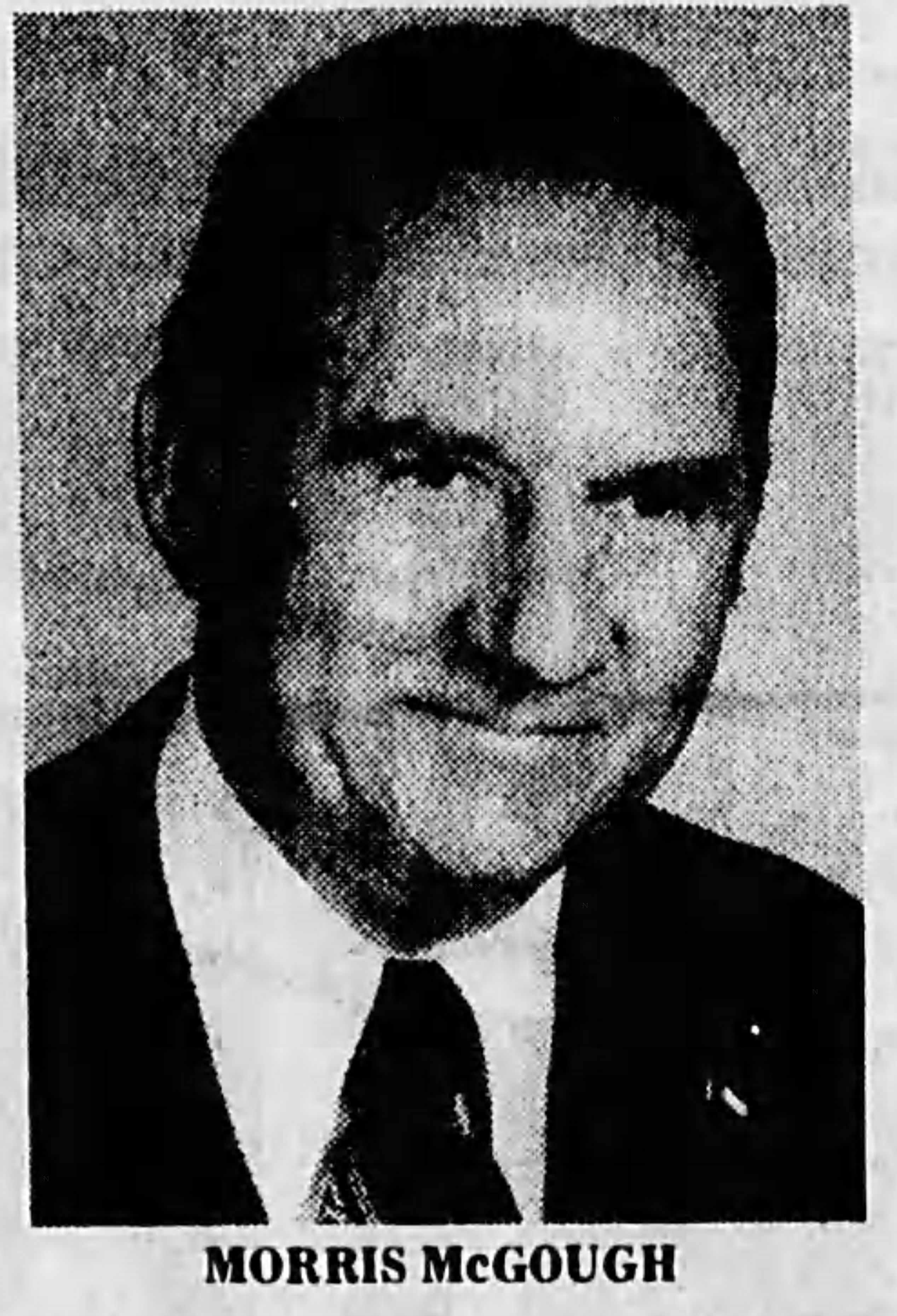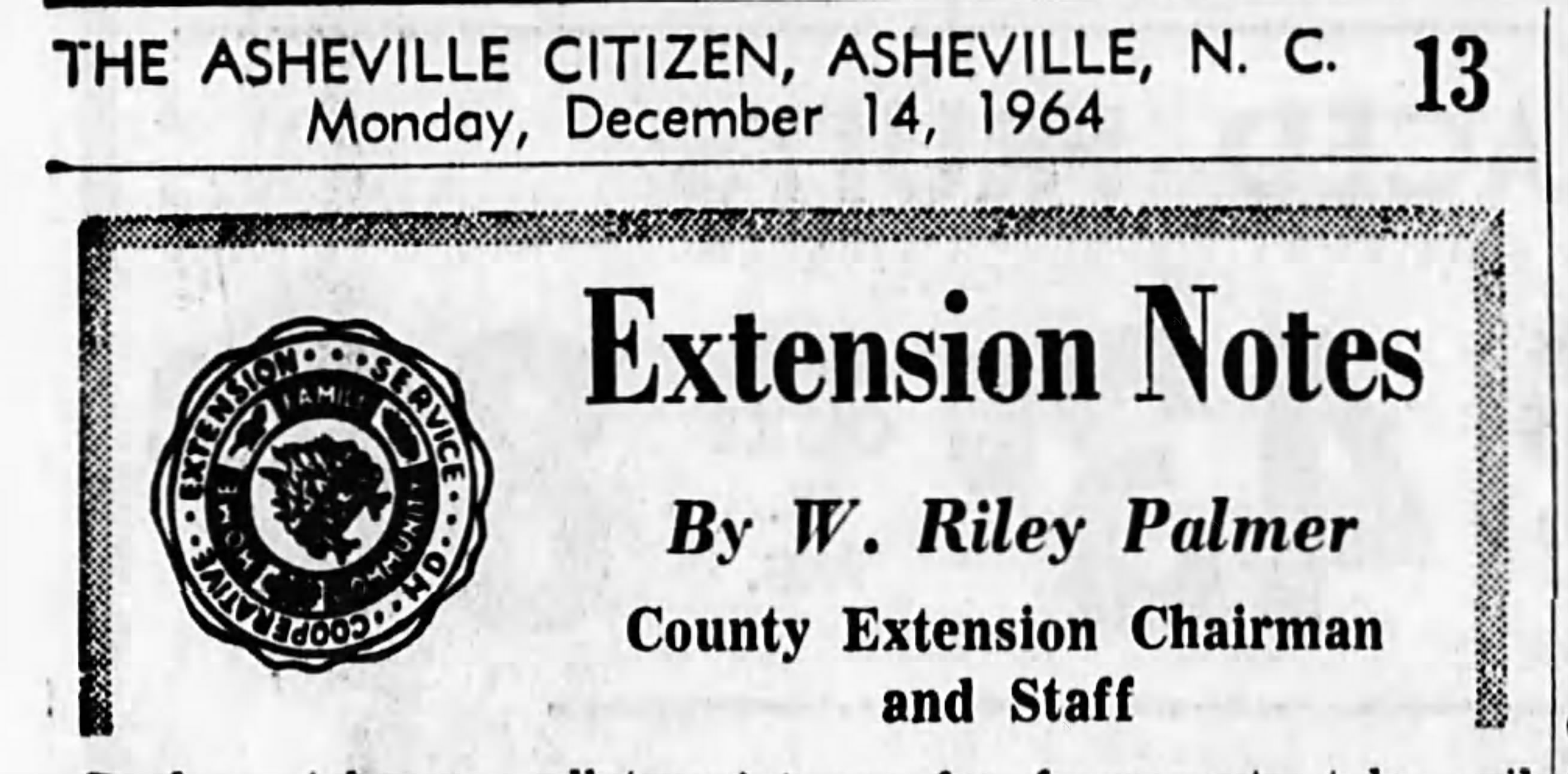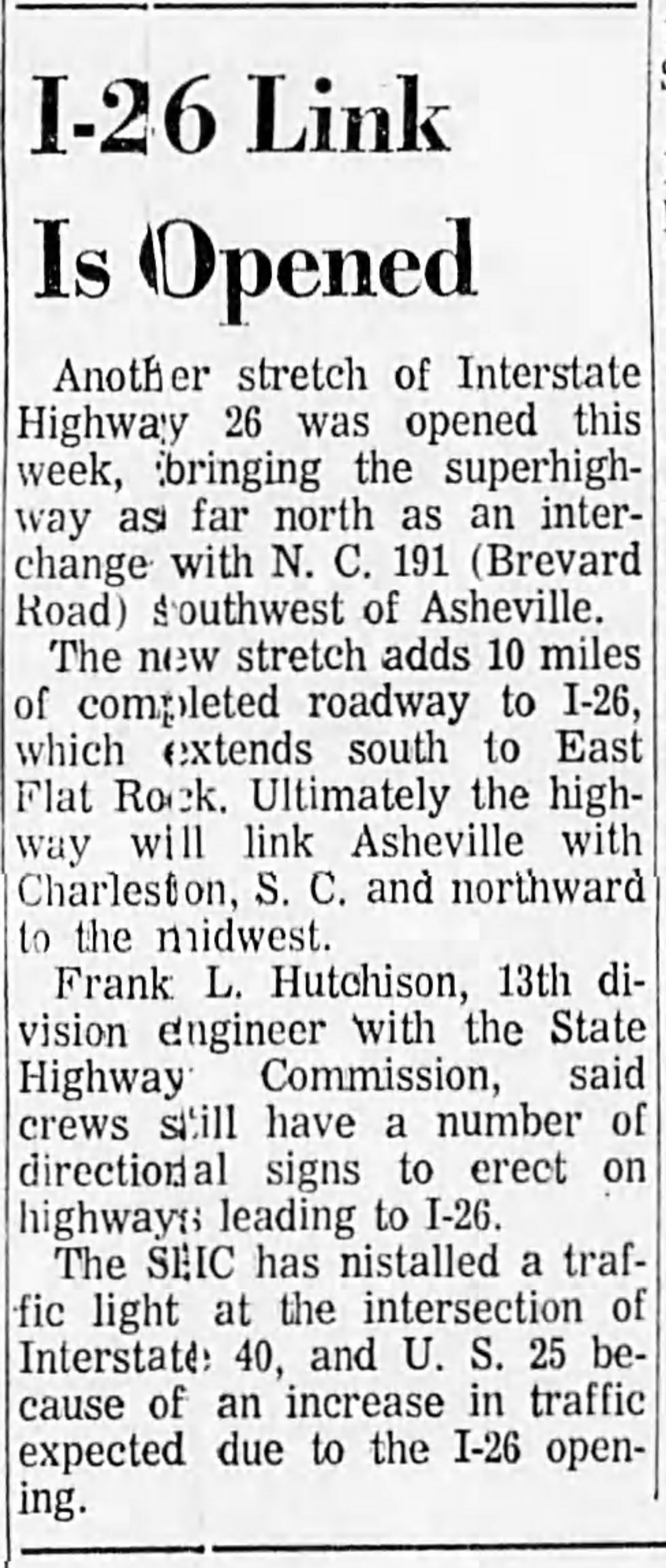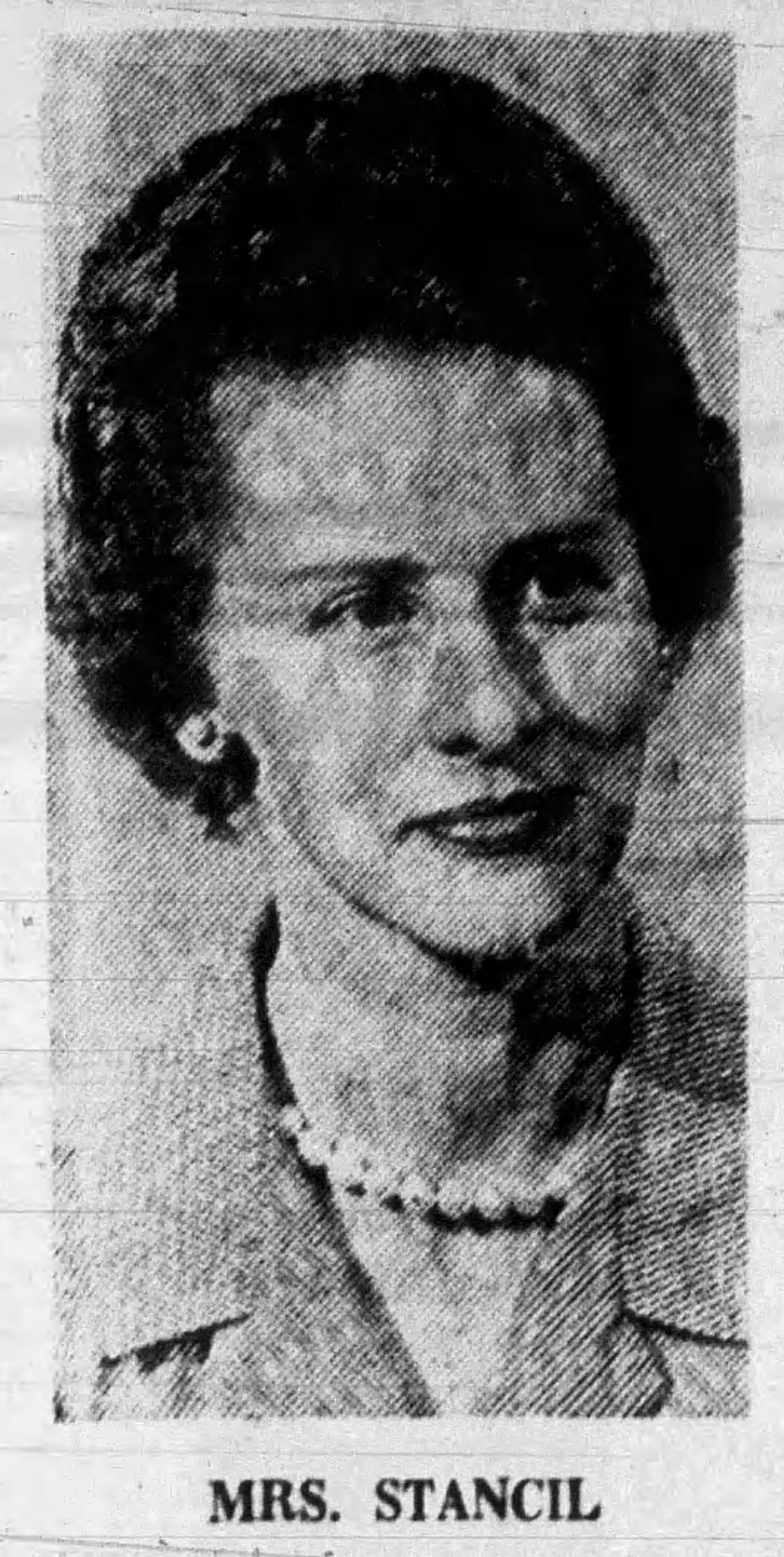Buncombe County Cooperative Extension : The 1960s
go.ncsu.edu/readext?1073341
en Español / em Português
El inglés es el idioma de control de esta página. En la medida en que haya algún conflicto entre la traducción al inglés y la traducción, el inglés prevalece.
Al hacer clic en el enlace de traducción se activa un servicio de traducción gratuito para convertir la página al español. Al igual que con cualquier traducción por Internet, la conversión no es sensible al contexto y puede que no traduzca el texto en su significado original. NC State Extension no garantiza la exactitud del texto traducido. Por favor, tenga en cuenta que algunas aplicaciones y/o servicios pueden no funcionar como se espera cuando se traducen.
Português
Inglês é o idioma de controle desta página. Na medida que haja algum conflito entre o texto original em Inglês e a tradução, o Inglês prevalece.
Ao clicar no link de tradução, um serviço gratuito de tradução será ativado para converter a página para o Português. Como em qualquer tradução pela internet, a conversão não é sensivel ao contexto e pode não ocorrer a tradução para o significado orginal. O serviço de Extensão da Carolina do Norte (NC State Extension) não garante a exatidão do texto traduzido. Por favor, observe que algumas funções ou serviços podem não funcionar como esperado após a tradução.
English
English is the controlling language of this page. To the extent there is any conflict between the English text and the translation, English controls.
Clicking on the translation link activates a free translation service to convert the page to Spanish. As with any Internet translation, the conversion is not context-sensitive and may not translate the text to its original meaning. NC State Extension does not guarantee the accuracy of the translated text. Please note that some applications and/or services may not function as expected when translated.
Collapse ▲The 1960s was a turbulent time in American history. The decade was overcome with racial tension, riots, assassinations, and war. Change occurred at a rapid rate and left many wondering their place in society.
A spark of courage ignited in Greensboro, North Carolina, in 1960 when a group of four black NC A&T College students sat down at a segregated lunch counter of a Woolworth store and peacefully propelled the Civil Rights movement forward in the south. In 1962, fear held a strong grip on the nation as the Cuban Missile Crisis brought us closer to nuclear war than at any time ever before, and the assassination of President John F. Kennedy the following year left many with more questions than answers. In the wake of this tragedy, Lyndon B. Johnson became our nation’s 36th president. Highlights of his presidency include passing the Civil Rights Act of 1964, the Voting Rights Act of 1965, and implementing Medicare and Medicaid. The downfall of his presidency, though, was a subject on everyone’s mind by the end of the decade: Vietnam.
From 1955 until 1975 conflict ensued between North Vietnam and South Vietnam, with the United States supporting non-communist South Vietnam. America’s troops entered the war on March 8, 1965 when 3,500 US marines landed at Da Nang Bay. By December, nearly 200,000 American soldiers had been deployed.
Toward the decade’s end, the assassinations of Martin Luther King, Jr and Robert F. Kennedy seemed a final, devastating blow to a nation already in distress.
Buncombe County witnessed progress with the opening of the Asheville Regional Airport and the construction of Interstate 26. Commercial tomato crops gained popularity in the area and the opening of the WNC Agricultural Center opened up new opportunities for area farmers and 4-H youth groups.
1960
Total farm income for Buncombe County is estimated at $15,416,600 (approximately $147,229,530 in 2025’s dollars). Poultry ranked the top money maker for Buncombe County farmers, followed by dairying and tobacco.
January 15 – The $2.2 million Asheville Regional Airport officially opens. Three airlines, Capital (later United), Delta, and Piedmont offered a total of 21 flights. The modern 25,060 square foot terminal building remained under construction until its completion on June 7, 1961, at which point the new airport became fully functional.

New Asheville Airport with United Airliner and Terminal Building.
Buncombe County Special Collections, Pack Memorial Public Library, Asheville, North Carolina.
1963
June 17 – Legislation is passed to establish the WNC Agricultural Center, envisioned as a “showplace for 4-H and FFA cattle events as well as other regional agricultural activities” (1). The idea originated within the Asheville Agricultural Development Council, led by its executive vice president, Morris L McGough. Today, the McGough Arena at the WNC Ag Center continues this tradition by hosting equine and livestock shows, rodeos, and a variety of other events.
Morris McGough, known as the “Father of Community Development in WNC,” was born June 19, 1922 in Collinston, Louisiana. McGough’s journey to Western North Carolina began in 1948 when he arrived in Asheville as part of a Rural Area study. This initiative aimed to appraise agricultural resources and develop plans to unite farmers and businessmen for agricultural development in the region. From this, the Asheville Agricultural Development Council (today’s WNC Communities non-profit organization) was formed in February, 1949.
McGough was instrumental in a large number of projects that benefit our region today. He helped establish the WNC Ag Center, the WNC Farmers Market, the expansion of the Mountain Horticultural Crops Research Station, and the construction of the NC Arboretum. He participated in efforts to convert a section of Highway 19/23 into Future Interstate 26, from the I-240 interchange (present-day Jeff Bowen Bridge) north into Madison County.
Dedicated to working with rural and farming communities, McGough fostered projects that enhanced their quality of life. He helped establish “community clubs”– groups of citizens working together through various projects to elevate others in their own community. These community clubs remain active today under the guidance of WNC Communities. McGough died January 15, 2011 at age 88.
August 12 – Bobby Peek joins Buncombe County Cooperative Extension as the new 4-H Agent.
Bobby Peek continued his career at Buncombe County Cooperative Extension from 1963 until retiring as the Extension Horticulture Agent in 1988. Mr. Peek continues to reside in Buncombe County.
1964
March 12 – The Asheville Citizen newspaper announces that Buncombe County will be home to the new WNC Agricultural Center.
December 14 – The first “Extension Notes” column is published in the Asheville Citizen newspaper. A regular feature from 1964 until 1997, the column was written by Buncombe County Cooperative Extension staff members. Designed to serve both agricultural and homemaking audiences, a wide array of topics were covered, from farming and gardening practices to in-season crop highlights, practical homemaking advice, Cooperative Extension events, and updates on 4-H club activities.
Buncombe County Cooperative Extension continues to publish an online monthly newsletter on these topics and more. Visit our website at buncombe.ces.ncsu.edu to view our upcoming events and activities. To sign up for our newsletters, click “Newsletters” in the left column.
1965
February – After two years of experimentation, the Biltmore Estate announces a new initiative to market cherry tomatoes. They provided disease-treated Red Cherry variety seeds at $1 an ounce or greenhouse-grown seedlings at 10 cents per peat pot. Farmers were paid weekly at market price for delivered fruit. By July, 48 Buncombe County farmers were growing 1 to 2 acres plots, establishing a new local industry.
1966
January – Buncombe County is selected as one of six counties to participate in the “Operation Expansion” project aimed at expanding 4-H club opportunities for the youth of our county. No longer considered a rural program, new projects included photography, communication, dog care, money management, and leadership skills.
4-H clubs still have a presence in Buncombe County, with two new clubs beginning in May, 2025. Upcoming opportunities for youth include the 4-H Horse Club, the new 4-H Ridgecrest Community Club, and Summer Fun day camps being held June through August. See our website for details.
October 31 – Home Demonstration Agent Mary Ray is featured as “Woman of the Week” in the Asheville Citizen newspaper.
Mary Ray began her career at Buncombe County Cooperative Extension in 1953, serving as Assistant Home Demonstration Agent under the guidance of Mamie Sue Evans. She was appointed Home Demonstration Agent January 1, 1958, after Evans’ retirement. She resigned from the position in 1967 to become a full time homemaker, dedicating her time to raising her children.
Born December 30, 1931, she married Leroy Ray of Burnsville, Yancey County, in 1957. The couple lived in Asheville and owned Ray’s Home Improvement Company in the Bledsoe Building on Haywood Road in West Asheville and later on Patton Avenue.
1967
January 12 – A fifteen mile section of the newly constructed Interstate 26 is opened from East Flat Rock (Upward Road) in Henderson County to the Asheville Airport. Meanwhile, a section of Interstate 40, between Exit 44 (Candler) to the Haywood County line, remained under construction. Interstate 40 between Exit 50 (Hendersonville Road) and Black Mountain did not yet exist.
May – Mary Cole is recognized for 20 years of secretarial service to Buncombe County Cooperative Extension.
July – Approximately 10 miles of newly constructed Interstate 26, from the Asheville Airport to Brevard Road, is opened to traffic.
December 1 – Mrs. Nancy Stancil is appointed Home Demonstration Agent for Buncombe County, having served as Assistant Home Demonstration Agent with Mary Farmer.
A native of Surry County, North Carolina, Nancy Stancil began work with Wake County Cooperative Extension in 1943. After her 1946 marriage to Robert Stancil she focused on raising her family only to return to employment with the NC Extension Service in Buncombe County in 1964. She retired from her position as Home Demonstration Agent in December, 1984.
1968
August 9 – The newly completed Interstate 26 and Interstate 40 interchange opens for travel.

The Asheville Citizen newspaper.
Friday, August 9, 1968.
Page 17.
Note: Sand Hill Road crosses over Interstate 40 in the bottom of the photo. Interstate 26 runs horizontal. Sections of the “Appalachian Highway” mentioned later became today’s I-240 and Future 26, north of downtown Asheville.
1969
February 3 – Twenty five members of the Buncombe County Agricultural Extension Service Advisory Board meet and plan Extension work for 1969 and beyond. One special topic of discussion was the need for a new farmers market. Since 1938 farmers had sold their produce and goods at an open air market at Lexington and Hiawasee Streets in downtown Asheville. A market on Riverside Drive was also threatened by continuing construction of the “Appalachian Highway” running north between downtown Asheville and Madison County, parts of which would later become Future I-26. With the Central Asheville Association approving a downtown site for the new Asheville Coliseum in 1968, proposed construction plans displaced this open market, as seen in the newspaper photo below. Though these plans never came to fruition, the need for a new farmers market began to take shape.
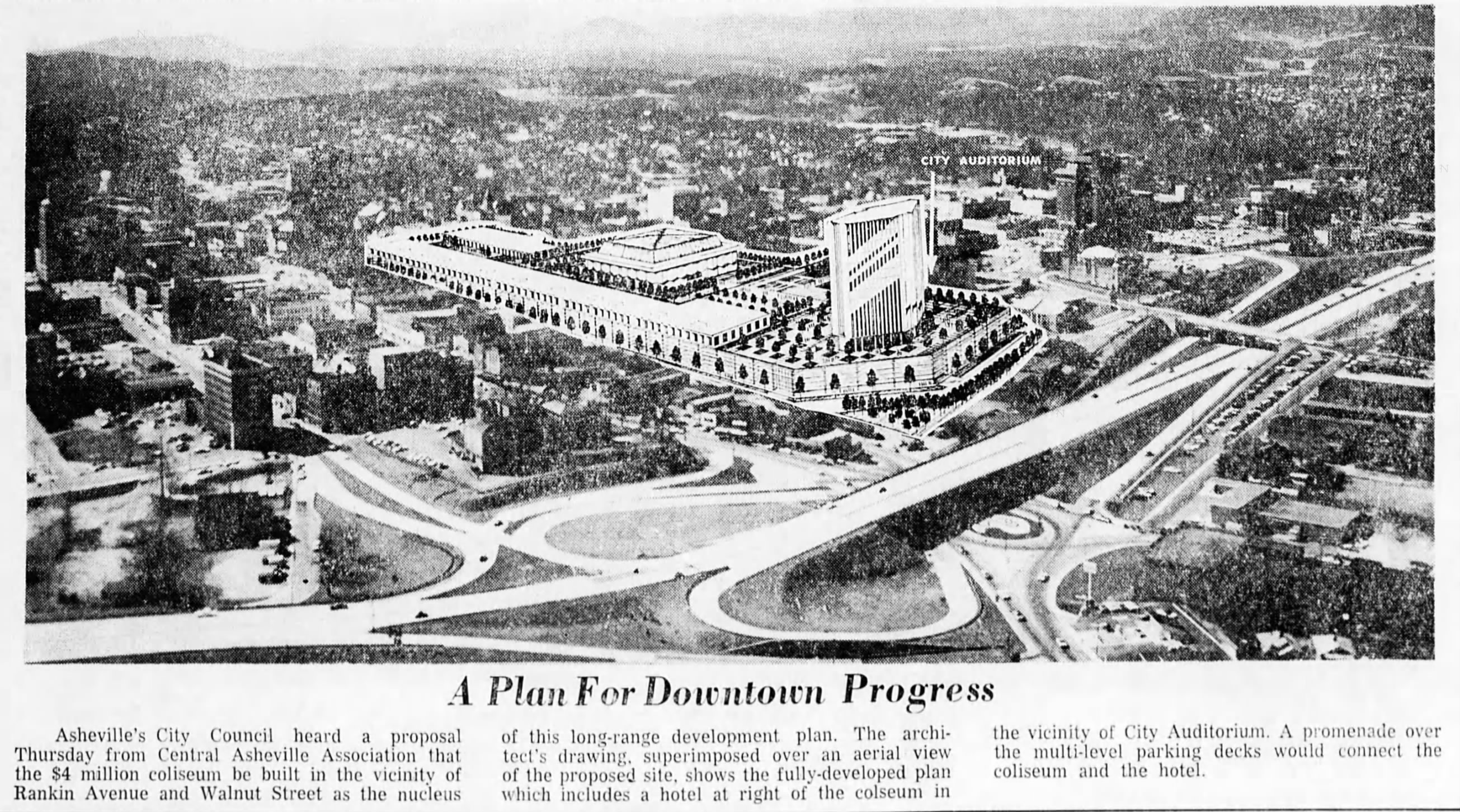
Proposed plan for the future Asheville Coliseum (present-day Harrah’s Cherokee Center – Asheville).
Asheville Citizen newspaper.
Friday, April 5, 1968.
Page 14.
The 1960s proved to be a decade of substantial change for the country as well as for Buncombe County. The decade saw the arrival of the Asheville Regional Airport, Interstates 26 and 40, the WNC Agricultural Center, and efforts to expand businesses and opportunities in downtown Asheville.
The FFA (Future Farmers of America) started accepting female members in 1969 at at a time when women were at the forefront of change. The 1970s would see much progress in women’s rights in employment, educational opportunities, and access to occupations previously dominated by men.
Check back in July when we explore the changes and events, both big and small, of agriculture and Buncombe County Cooperative Extension during the 1970s.
Follow us all year long as we explore each decade of North Carolina Cooperative Extension work in Buncombe County:
Buncombe County Cooperative Extension: Beginnings to 1920
Buncombe County Cooperative Extension: The 1920s
Buncombe County Cooperative Extension: The 1930s
Buncombe County Cooperative Extension: The 1940s
Buncombe County Cooperative Extension : The 1950s
Sources:
“Agricultural Center for WNC Is Assured.” The Asheville Times, 18 June 1963, p. 3, Accessed 26 May 2025.
“Agricultural Center Will Locate Here.” The Asheville Citizen, 12 Mar. 1964, p. 21, Accessed 26 May 2025.
Bernard, Smith R. “Buncombe Farm Income Is Estimated At $15,416,600.” The Asheville Times, 19 Dec. 1960, p. 13, Accessed 26 May 2025.
“Board of Directors.” WNC Communities, WNC Communities, wnccommunities.org/board-of-directors/. Accessed 26 May 2025.
Boyle, John. “McGough Endowment Fund, Service Planned.” The Asheville Citizen Times, 23 Feb. 2011, pp. B1–B3, Accessed 26 May 2025.
Clark, Philip. “New Asheville Airport Aids Area.” Asheville Citizen Times, 25 June 1961, pp. 79–85, Accessed 26 May 2025.
Coulter, Adam. “Avery’s Creek United Methodist Church – Celebrating 150 Years.” Unpublished. 2019.
Cowles, Mary. “I-26, I-40 Interchange Opens Today.” The Asheville Citizen, 9 Aug. 1968, pp. 1, 12–17, Accessed 26 May 2025.
“Extension Agent Mary F. Ray Dies.” The Asheville Citizen, 13 Mar. 1987, p. 20, Accessed 26 May 2025.
“Farmer – Ray Vows Spoken in Murphy.” Asheville Citizen Times, 29 Dec. 1957, p. 21, Accessed 26 May 2025.
“Farmers Visit Cherry Tomato Packing Site.” The Asheville Citizen, 1 July 1965, p. 24, Accessed 26 May 2025.
Hensley, Jay. “Downtown Site Proposed for Asheville Coliseum.” The Asheville Citizen, 5 Apr. 1968, pp. 1–14.
“I-26 Link Is Opened.” The Asheville Citizen, 27 July 1967, p. 13, Accessed 26 May 2025.
Irby, Laurens. “SHC Chairman Tells Lions 4-Lane Enka Highway Next.” The Asheville Citizen, 15 June 1967, p. 1, Accessed 26 May 2025.
“Major Road Building Gains Seen for WNC in 1967.” The Asheville Citizen Times, 29 Jan. 1967, p. E14, Accessed 26 May 2025.
Mebane, Bill. “Big Highways Are Really Rolling in WNC.” The Asheville Citizen Times, 28 Jan. 1968, p. E9, Accessed 26 May 2025.
“Morris L. ‘Mac’ McGough .” The Asheville Citizen Times, 20 Feb. 2011, p. B3, Accessed 26 May 2025.
“Mrs. Nancy Stancil.” The Asheville Citizen, 18 Aug. 1964, p. 7, Accessed 26 May 2025.
“Mrs. Ray Resigns Home Economics Post; Succeeded By Mrs. Stancil.” The Asheville Times, 7 Nov. 1967, p. 5, Accessed 26 May 2025.
“New Interchange Opens to Traffic.” The Asheville Times, 9 Aug. 1968, p. 1, Accessed 26 May 2025.
Palmer, W. Riley. “Extension Notes.” The Asheville Citizen, 24 Jan. 1966, p. 11, Accessed 26 May 2025.
Palmer, W. Riley. “Extension Notes.” The Asheville Citizen, 8 Feb. 1965, p. 9, Accessed 26 May 2025.
Parris, John. “15-Mile Section of I-26 Is Opened.” The Asheville Citizen, 13 Jan. 1967, pp. 1–3, Accessed 26 May 2025.
“Senate OK’s Ag Center Site Here.” The Asheville Citizen, 29 May 1964, p. 1, Accessed 26 May 2025.
Walcott, Mary Ellen. “Her Job: Keeping Up with Changing Lifestyle.” The Asheville Citizen Times, 13 Jan. 1985, pp. 1C-14C, Accessed 26 May 2025.
Wells, Richard. “Extension Advisory Board Reviews 1968 Activities.” The Asheville Citizen, 4 Feb. 1969, p. 17, Accessed 26 May 2025.
“WNC’s Fifty Most Influential People of the Century.” The Asheville Citizen Times, 31 Dec. 1999, pp. 26–27, Accessed 26 May 2025.






